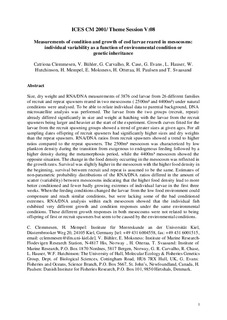| dc.contributor.author | Clemmesen, Catriona | |
| dc.contributor.author | Bühler, Vivian | |
| dc.contributor.author | Carvalho, Gary R. | |
| dc.contributor.author | Chase, R. | |
| dc.contributor.author | Evans, Geoffrey T. | |
| dc.contributor.author | Hauser, Lorenz | |
| dc.contributor.author | Hutchinson, William F. | |
| dc.contributor.author | Mempel, Helgi | |
| dc.contributor.author | Moksness, Erlend | |
| dc.contributor.author | Otterå, Håkon | |
| dc.contributor.author | Paulsen, Helge | |
| dc.contributor.author | Svåsand, Terje | |
| dc.date.accessioned | 2012-10-23T20:32:38Z | |
| dc.date.available | 2012-10-23T20:32:38Z | |
| dc.date.issued | 2001 | |
| dc.identifier.citation | This report is not to be cited without prior reference to the authors | no_NO |
| dc.identifier.uri | http://hdl.handle.net/11250/106215 | |
| dc.description.abstract | Size, dry weight and RNA/DNA measurements of 3876 cod larvae from 26 different families
of recruit and repeat spawners reared in two mesocosms ( 2500m³ and 4400m³) under natural
conditions were analysed. To be able to relate individual data to parental background, DNA
microsatellite analysis was performed. The larvae from the two groups (recruit, repeat)
already differed significantly in size and weight at hatching with the larvae from the recruit
spawners being larger and heavier at the start of the experiment. Growth curves fitted for the
larvae from the recruit spawning groups showed a trend of greater sizes at given ages. For all
sampling dates offspring of recruit spawners had significantly higher sizes and dry weights
than the repeat spawners. RNA/DNA ratios from recruit spawners showed a trend to higher
ratios compared to the repeat spawners. The 2500m³ mesocosm was characterized by low
plankton density during the transition from exogenous to endogenous feeding followed by a
higher density during the metamorphosis period, while the 4400m³ mesocosm showed the
opposite situation. The change in the food density occurring in the mesocosm was reflected in
the growth rates. Survival was slightly higher in the mesocosm with the higher food density in
the beginning, survival between recruit and repeat is assumed to be the same. Estimates of
non-parametric probability distributions of the RNA/DNA ratios differed in the amount of
scatter (variability) between mesocosms indicating that the higher food density lead to more
better conditioned and fewer badly growing extremes of individual larvae in the first three
weeks. When the feeding conditions changed the larvae from the low food environment could
compensate and reach similar conditions, but were lacking some of the bad conditioned
extremes. RNA/DNA analysis within each mesocosm showed that the individual fish
exhibited very different growth and condition responses under the same environmental
conditions. These different growth responses in both mesocosms were not related to being
offspring of first or recruit spawners but seem to be caused by the environmental conditions. | no_NO |
| dc.language.iso | eng | no_NO |
| dc.publisher | ICES | no_NO |
| dc.relation.ispartofseries | ICES CM Documents;2001/V:8 | |
| dc.subject | cod | no_NO |
| dc.subject | torsk | no_NO |
| dc.subject | fish larvae | no_NO |
| dc.subject | fiskelarver | no_NO |
| dc.subject | growth | no_NO |
| dc.subject | vekst | no_NO |
| dc.subject | genetics | no_NO |
| dc.subject | genetikk | no_NO |
| dc.title | Measurements of condition and growth of cod larvae reared in mesocosms: individual variability as a function of environmental condition or genetic inheritance | no_NO |
| dc.type | Working paper | no_NO |
| dc.subject.nsi | VDP::Mathematics and natural science: 400::Zoology and botany: 480::Marine biology: 497 | no_NO |
| dc.subject.nsi | VDP::Agriculture and fishery disciplines: 900::Fisheries science: 920::Fish health: 923 | no_NO |
| dc.subject.nsi | VDP::Agriculture and fishery disciplines: 900::Fisheries science: 920::Resource biology: 921 | no_NO |
| dc.source.pagenumber | 20 s. | no_NO |
